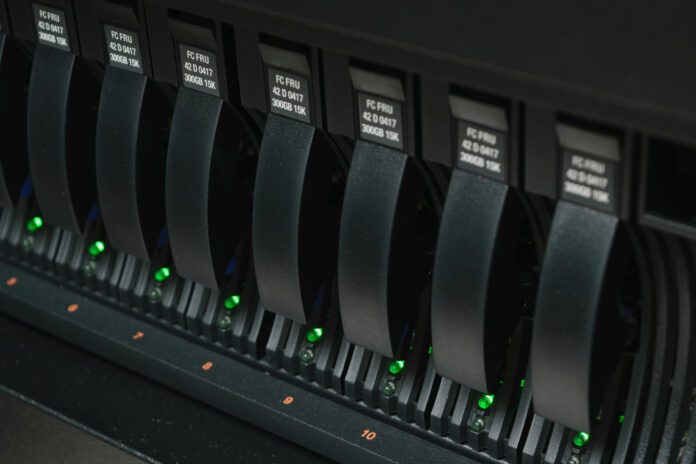With advances in technology, RAID has evolved from a server-only option to a reliable source of higher storage capacity, improved performance and data security. And now that everyone is more interested in using software-based components for their storage infrastructure, RAID seems to be a promising storage technology among users.
Both businesses and home users are opting for software RAID over hardware RAID. Although RAID is a fairly effective storage technology on its own, when embedded in a NAS setup, it offers numerous other benefits to its users.
This article looks at the basics of hardware RAID, software RAID and NAS devices and which option is best for home users. Understanding the differences, strengths and requirements is essential to making the right decision while keeping all data in view. Read on to find out more!
What is Hardware RAID?
Hardware RAID is the first RAID configuration. It involved multiple storage drives and a separate controller (independent of the operating system), including PCIe RAID controller cards or RAID controllers integrated into the motherboard. The controller connects two or more drives to the computer in an array and makes them all appear as one logical unit.
The hardware controllers are self-contained and have cache memory, processors and firmware specifically designed for RAID operation. In the event of a malfunction or failure, hardware RAID controllers can be replaced with controllers from the same manufacturer and of the same generation.
Hardware RAID is usually associated with SAS-based drives that require a host bus adapter. These SAS adapters are available with internal connectors for connection to the server or with external connectors for connecting JBOD(s), SAS or both, providing flexibility and scalability for the RAID setup.
Hardware RAID drives are largely plug-and-play configurations that are stored on cards. Drive management is available through the adapter’s BIOS before it enters the host operating system (OS). This means that the host adapter accepts the RAID volumes as physical drives and takes the burden of drive management off the OS, making hardware RAIDs compatible with almost all operating systems.
Advantages of Hardware RAID
- Hardware RAID is much faster, more reliable and easier to configure.
- A dedicated hardware RAID controller takes the burden of hard drive management off the operating system and requires no computing power.
- The RAID controller cards can be swapped between models from the same manufacturer in the event of a controller failure, making hardware RAID flexible and easily scalable.
- Thanks to the individual RAID controllers, it is easy to replace a defective or damaged hard drive in the hardware RAID.
Disadvantages of Hardware RAID
- Although it does not take any computing power away from the hard drives, it is somewhat expensive as it requires hardware components and a special controller to function properly.
- Sometimes hardware RAID can cause compatibility issues with the operating system.
- There can be performance issues when using storage drives such as SSDs, as RAID is not a good choice for flash-based storage drives in terms of performance. Even in comparison, a single SSD can outperform a RAID in common scenarios.
What is Software RAID?
Software RAID is created with hard disk controller software embedded in the computer system. The operating system or the specialised software handles the processes in software RAID, using the computing resources of the host system’s CPU. In this RAID configuration, several hard disks are combined to form a complete array. Even the RAID functionality and data storage mechanisms, including striping, mirroring and parity, are performed by the software layer in software RAID.
Software RAID requires more interaction between the user and the operating system during configuration. Since the RAID controller remains a part of the operating system itself, software RAID is compatible with the host operating system by default. No special manufacturer or hardware-related specifications and solutions are required.
Compared to hardware RAID, it offers great flexibility in terms of supported RAID levels, operating systems and other settings. It is also more cost-effective as no separate controller card or chip is required. However, the connected devices must be compatible with the host operating system.
Advantages of Software RAID
- It is cheaper than hardware RAID as no hardware RAID controller is required.
- It can be implemented in an operating system and can be accessed by multiple devices.
- The hard disks in the software RAID array are treated by the controller as part of the host computer.
Disadvantages of Software RAID
- Although software RAID can be accessed from multiple devices, it can slow down the data access function.
- Hot-swapping the hard drives in the software RAID array is more difficult than with hardware RAID, as the operating system must alert the RAID controller to shut it down.
Software RAID Vs Hardware RAID Quick Comparison
| Features | Software RAID | Hardware RAID |
| RAID Controller | No separate controller card is required | A dedicated hardware RAID controller is required |
| Performance & Flexibility | Relies on host CPU for I/O processing, affecting the overall system performance | Doesn’t rely on host system’s CPU for processing tasks, resulting in faster data transfer rates, and improved performance |
| Access Speed | Better access speed based on the controller software and drives | Hardware controller, network and number of drives decide the access speed |
| Cost | Less expensive since there is no need for a separate RAID controller | Expensive than software RAID as it needs a dedicated separate RAID controller to take off the load from OS |
| Operating System | It uses the associated OS and driver in the OS to function | It works independently of OS. |
| Data Recovery | Can be done by rebuilding RAID using a dedicated RAID data recovery software such as Stellar Data Recovery Technician | Can be done by an advanced data recovery software, treating the whole NAS setup as one logical unit such as Stellar Toolkit for Data Recovery |
What is NAS (Network Attached Storage)?
NAS is also a data storage technology that facilitates access to stored system data for all networked devices. It is a file-level data storage architecture that combines both hardware and software to provide ample storage space on the computer and facilitate the process of file sharing. It is considered the best option for storing unstructured data such as documents, images, spreadsheets, PPTs, etc. and allows multiple people to access the same data at the same time.
It is quite scalable as more hard drives can be added to the setup to increase the storage capacity. In the past, only hard drives were integrated into the NAS setup. Today, however, several NAS solution providers are integrating RAID levels to improve not only storage capacity but also performance and data redundancy.
Difference Between RAID and NAS
RAID is a file system technology configured with two or more hard drives and a controller that helps manage the data. It acts as a logical unit and is available in different levels, e.g. RAID 0, 1, 5, 6 and Nested RAIDs (RAID 10, 50, 60).
NAS is a file-level storage architecture that can be set up with single or multiple hard drives or even RAID levels. It provides authorised users and heterogeneous clients with a single point of access to store and share data over a network.
Once the RAID level has been configured, the data is stored on the assigned drives. Additional drives can be added to the level. These additional drives in the RAID configuration are useful for hot-swapping in the event of RAID controller malfunctions, logical errors in RAID levels or similar problems.
On the other hand, a NAS is scalable. You can add more drives to increase the storage capacity of the NAS device. NAS storage utilises a bay structure to accommodate additional drives, resulting in more space and efficiency. When NAS is configured with RAID, similar problems can occur as with RAID drives.
The Best Choice for You as a Home User!
RAID and NAS are two different storage technologies, each with their own advantages and challenges. Therefore, it is quite difficult to say that one is better than the other. You should always consider your requirements and other factors such as cost, environment, etc. to decide which is the best option.
The best way to utilise the maximum performance is to combine both systems i.e. using NAS with RAID for home to achieve great data storage, improved performance, data security, data accessibility and more.
Plus, you can make a better decision by comparing the two devices. If you’re looking for the ability to connect multiple workstations to access similar information and data, a NAS setup is best. If you’re just looking for better storage, performance and data redundancy, choose RAID levels that offer fault tolerance.
As for data recovery from both software-hardware RAID and NAS drives, you can rely on Stellar’s range of specialized data recovery software. With the Technician version, you can virtually rebuild a RAID for RAID data recovery from a faulty or failed RAID array. However, with the Toolkit version of the software, you can also recover data from NAS RAIDs and virtual machines.
Find a Home-Based Business to Start-Up >>> Hundreds of Business Listings.















































